
Handy Links
SLAC News Center
SLAC Today
- Subscribe
- Archives: Feb 2006-May 20, 2011
- Archives: May 23, 2011 and later
- Submit Feedback or Story Ideas
- About SLAC Today
SLAC News
Lab News
- Interactions
- Lightsources.org
- ILC NewsLine
- Int'l Science Grid This Week
- Fermilab Today
- Berkeley Lab News
- @brookhaven TODAY
- DOE Pulse
- CERN Courier
- DESY inForm
- US / LHC
SLAC Links
- Emergency
- Safety
- Policy Repository
- Site Entry Form

- Site Maps
- M & O Review
- Computing Status & Calendar
- SLAC Colloquium
- SLACspeak
- SLACspace
- SLAC Logo
- Café Menu
- Flea Market
- Web E-mail
- Marguerite Shuttle
- Discount Commuter Passes
-
Award Reporting Form
- SPIRES
- SciDoc
- Activity Groups
- Library
Stanford
Around the Bay
New SPEAR3 Diagnostic Beamline Up and Running
 The diagnostic beamline at SPEAR3 opened for business in February and is already producing
high quality measurements. SPEAR3 emits pulses of synchrotron radiation composed of photons
with a range of wavelengths concentrated in the x-ray region, but extending to ultraviolet,
visible and infrared as well.
The diagnostic beamline at SPEAR3 opened for business in February and is already producing
high quality measurements. SPEAR3 emits pulses of synchrotron radiation composed of photons
with a range of wavelengths concentrated in the x-ray region, but extending to ultraviolet,
visible and infrared as well.
The diagnostic beamline works with visible and ultraviolet wavelengths to quantify physical properties of the electron beam circulating in SPEAR3 that generates synchrotron radiation. Jeff Corbett, Cecile Limborg and members of the SSRL accelerator systems department spent several years constructing it.
One of the beamline's first jobs was to measure the time duration of individual photon pulses with a streak camera on loan from the Advanced Light Source in Berkeley. Researchers interested in time-resolved studies, where a short pulse sheds more light on fast phenomena, need to know the exact pulse duration used to generate their data. Initial measurements confirmed that in normal SPEAR3 operating mode the photon pulses are 40 picoseconds long (measured at full-width half-maximum, FWHM).
The diagnostic beamline is now a key part of efforts to reduce the photon pulse length. Accelerator physicists Xiaobiao Huang and James Safranek are testing a new mode for SPEAR3 magnets to reduce the pulse length down to about 10 picoseconds (FWHM), a remarkable feat that was recorded at the diagnostic beamline. By adjusting the storage ring magnets to the ‘low-alpha’ mode, individual electrons in each bunch remain closer together in time as they circulate around the accelerator, resulting in the short bunch length. Today, May 19, the team will test this machine configuration at higher current with a total of 280 circulating electron bunches.
The streak camera measurements also rely on a 'synchroscan' unit on loan from the Advanced Photon Source (APS) in Illinois. Collaborators on the diagnostic beamline include PEP-II’s Alan Fisher, Alex Lumpkin of APS, and SSRL scientists Walter Mok and Jim Sebek.
—Heather Rock Woods SLAC Today, May 19, 2006
Image: Streak camera images of SPEAR 3 bunch length with normal magnet settings (left) and optimized magnet settings (right).